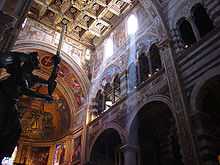Matroneum
From Wikipedia, the free encyclopedia

The matroneum of Pisa Cathedral protected by triforia and bifora
A matroneum (earlier also matronaeum; plural: matronea or matronaea) in architecture is a gallery on the interior of a building, originally intended to accommodate women (whence the derivation from "matron").[1]
In medieval churches matronea lost their function of accommodation and became purely architectonic elements, placed over the side aisles with the structural purpose of containing the thrust of the central nave, and came to consist solely of bays so placed.
In Early Gothic churches the matronea were one of the four elements which constituted the interior walls (arch, matroneum, triforium and clerestory), but they grew rare in the succeeding period of full-blown Gothic architecture
Notes
- ↑ According to Valerio Ascani, professor of the history of medieval art at the University of Pisa, this definition is inaccurate: matronea were in fact intended for all persons who could not, or did not want to, enter the main body of the church below. including men as well as women, although the sexes were always separated to left and right: Valerio Ascani, Il trecento disegnato - Le basi progettuali dell'architettura gotica in Italia
References
- Ascani, Valerio, 1997: Il trecento disegnato - Le basi progettuali dell'architettura gotica in Italia, Edizioni Viella, 1997, ISBN 88-85669-62-X.
This article is issued from Wikipedia. The text is available under the Creative Commons Attribution/Share Alike; additional terms may apply for the media files.